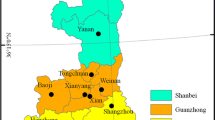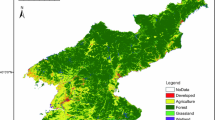Abstract
Taking the “One Million-Mu (666 km2)” Plain Afforestation (Phase I) Project (Phase I afforestation) in Beijing city as an example, we monitored the growth status of planted forest using long-term remote sensing images, and evaluated the impacts of afforestation on land use change and vegetation growth. We found there is a large space for improvement regarding the ecological benefits of the project. Moreover, we found forest patches with decreasing greenness after the afforestation were mainly converted from farmland with high greenness and low heterogeneity in terms of the normalized difference vegetation index (NDVI). This implies that those farmland patches are inappropriate for afforestation. According to the results from Phase I afforestation and the impact of urbanization on green space, we constructed a series of spatial variables and generated a suitability map for the next “New Round of One Million-Mu (666 km2) Afforestation project” (Phase II afforestation). We then modeled the spatial distribution of Phase II afforestation based on the derived suitability map. This study is crucial for the scientific evaluation of afforestation projects for space planning (e.g., urban green space planning). The evaluation and modeling framework built in this study can be used to support the decision making and policy implementation of afforestation projects in China.
Similar content being viewed by others
References
Bowler D E, Buyung-Ali L, Knight T M, Pullin A S. 2010. Urban greening to cool towns and cities: A systematic review of the empirical evidence. Landsc Urban Plan, 97: 147–155
Cao S, Liu Y, Su W, Zheng X, Yu Z. 2018. The net ecosystem services value in mainland China. Sci China Earth Sci, 61: 595–603
Cao X, Onishi A, Chen J, Imura H. 2010. Quantifying the cool island intensity of urban parks using aster and Ikonos data. Landsc Urban Plan, 96: 224–231
Chen F, Fu B, Xia J, Wu D, Wu S, Zhang Y, Sun H, Liu Y, Fang X, Qin B, Li X, Zhang T, Liu B, Dong Z, Hou S, Tian L, Xu B, Dong G, Zheng J, Yang W, Wang X, Li Z, Wang F, Hu Z, Wang J, Liu J, Chen J, Huang W, Hou J, Cai Q, Long H, Jiang M, Hu Y, Feng X, Mo X, Yang X, Zhang D, Wang X, Yin Y, Liu X. 2019. Major advances in studies of the physical geography and living environment of China during the past 70 years and future prospects. Sci China Earth Sci, 62: 1665–1701
Chen Y, Tong Y, Zhang L. 2015. Use of urban forest construction at home and abroad for reference to Beijing plain afforestation project (in Chinese). Land Greening, 5: 42–43
Clinton N, Gong P. 2013. Modis detected surface urban heat islands and sinks: Global locations and controls. Remote Sens Environ, 134: 294–304
Dong J W, Kuang W H, Liu J Y. 2018. Continuous land cover change monitoring in the remote sensing big data era. Sci China Earth Sci, 60: 2223–2224
Fang C, Gao Q, Zhang X, Cheng W. 2019. Spatiotemporal characteristics of the expansion of an urban agglomeration and its effect on the ecoenvironment: Case study on the northern slope of the Tianshan Mountains. Sci China Earth Sci, 62: 1461–1472
Feng X, Ma T, Cai B, Duan J, Jia L, Jia Z, Wang J. 2016. Effectiveness evaluation based on the afforestine construction in Beijing plain (in Chinese). J Northwest Forest Univ, 31: 136–144
Foltête J C, Clauzel C, Vuidel G. 2012. A software tool dedicated to the modelling of landscape networks. Environ Model Softw, 38: 316–327
Franklin S E, He Y, Pape A, Guo X, McDermid G J. 2011. Landsat-comparable land cover maps using aster and spot images: A case study for large-area mapping programmes. Int J Remote Sens, 32: 2185–2205
Gong P, Liang S, Carlton E J, Jiang Q, Wu J, Wang L, Remais J V. 2012. Urbanisation and health in China. Lancet, 379: 843–852
Gorelick N, Hancher M, Dixon M, Ilyushchenko S, Thau D, Moore R. 2017. Google Earth engine: Planetary-scale geospatial analysis for everyone. Remote Sens Environ, 202: 18–27
Hu T, Huang X, Li X, Liang L, Xue F. 2019. Toward a better understanding of urban sprawl: Linking spatial metrics and landscape networks dynamics. In: Geertman S, Zhan Q, Allan A, Pettit C, eds. Computational Urban Planning and Management for Smart Cities. CUPUM 2019. Lecture Notes in Geoinformation and Cartography. Springer, Cham
Hu T, Yang J, Li X, Gong P. 2016. Mapping urban land use by using Landsat images and open social data. Remote Sens, 8: 151
Huang H, Chen Y, Clinton N, Wang J, Wang X, Liu C, Gong P, Yang J, Bai Y, Zheng Y, Zhu Z. 2017. Mapping major land cover dynamics in Beijing using all Landsat images in Google Earth Engine. Remote Sens Environ, 202: 166–176
Huang X, Wang Y. 2019. Investigating the effects of 3D urban morphology on the surface urban heat island effect in urban functional zones by using high-resolution remote sensing data: A case study of Wuhan, Central China. ISPRS J Photogramm Remote Sens, 152: 119–131
Huang X, Han X, Ma S, Lin T, Gong J. 2019. Monitoring ecosystem service change in the City of Shenzhen by the use of high-resolution remotely sensed imagery and deep learning. Land Degrad Dev, 30: 1490–1501
Jia B, Qiu K. 2017. The cooling effect of plain afforestation in the Beijing Project and its remote sensing-based valuation (in Chinese). Acta Ecol Sin, 37: 726–735
Kondo M C, Fluehr J M, McKeon T, Branas C C. 2018. Urban green space and its impact on human health. Int J Environ Res Public Health, 15: 445
Kuang W H, Yang T R, Liu A L, Zhang C, Lu D S, Chi W F. 2017. An Ecocity model for regulating urban land cover structure and thermal environment: Taking Beijing as an example. Sci China Earth Sci, 60: 1098–1109
Lee H, Mayer H, Chen L. 2016. Contribution of trees and grasslands to the mitigation of human heat stress in a residential district of Freiburg, Southwest Germany. Landsc Urban Plan, 148: 37–50
Li F, Wang R. 2006. Evaluation of Urban Green Space Service Efficacy and Ecological Planning (in Chinese). Beijing: China Meteorological Press
Li F, Wang R, Paulussen J, Liu X. 2005. Comprehensive concept planning of urban greening based on ecological principles: A case study in Beijing, China. Landsc Urban Plan, 72: 325–336
Li Q, Gu C. 2015. Dynamic geographical simulation for urban public Safety emergency response (in Chinese). Sci Sin Terrae, 45: 290–304
Li X, Gong P, Liang L. 2015. A 30-year (1984-2013) record of annual urban dynamics of Beijing city derived from landsat data. Remote Sens Environ, 166: 78–90
Li X, Gong P, Yu L, Hu T. 2017. A segment derived patch-based logistic cellular automata for urban growth modeling with heuristic rules. Comput Environ Urban Syst, 65: 140–149
Liu Z, Guan D, Wei W. 2018. Carbon emission accounting in China (in Chinese). Sci Sin Terrae, 48: 878–887
Lin H, Xue Y. 2018. Habitat, habitat environment and human city (in Chinese). Chin Sci Bull, 63: 14–15
Liu S, Gong P. 2012. Change of surface cover greenness in China between 2000 and 2010. Sci Bull, 57: 53–64
Maimaitiyiming M, Ghulam A, Tiyip T, Pla F, Latorre-Carmona P, Halik Ü, Sawut M, Caetano M. 2014. Effects of green space spatial pattern on land surface temperature: Implications for sustainable urban planning and climate change adaptation. ISPRS J Photogramm Remote Sens, 89: 59–66
Middel A, Chhetri N, Quay R. 2015. Urban forestry and cool roofs: Assessment of heat mitigation strategies in Phoenix residential neighborhoods. Urban For Urban Green, 14: 178–186
Roy D P, Wulder M A, Loveland T R, Curtis E W, Allen R G, Anderson M C, Helder D, Irons J R, Johnson D M, Kennedy R, Scambos T A, Schaaf C B, Schott J R, Sheng Y, Vermote E F, Belward A S, Bindschadler R, Cohen W B, Gao F, Hipple J D, Hostert P, Huntington J, Justice C O, Kilic A, Kovalskyy V, Lee Z P, Lymburner L, Masek J G, McCorkel J, Shuai Y, Trezza R, Vogelmann J, Wynne R H, Zhu Z. 2014. Landsat-8: Science and product vision for terrestrial global change research. Remote Sens Environ, 145: 154–172
Shi B, Yin H, Kong F. 2018. Assessment of the potential for urban facade greening in Xinjiekou District, Nanjing, China (in Chinese). Chin J Appl Ecol, 29: 1576–1584
Sun Y, Wang Q, Lu Z. 2005. Effects of urbanization on landscape pattern of Beijing (in Chinese). Chin J Appl Ecol, 16: 1366–1369
Tang X, Pan Y, Gao B, Gao Y. 2016. Evaluation of ecosystem service value of plain afforestation in Beijing (in Chinese). Acta Scientiarum Natur-alium Universitatis Pekinensis, 52: 274–278
Tao Y, Li F, Wang R, Zhao D. 2013. Research progress in the quantitative methods of urban green space patterns (in Chinese). Acta Ecol Sin, 33: 2330–2342
Tong W. 2019. Problems existing in afforestation in Beijing plain and related proposals for promoting the new round of afforestation (in Chinese). Beijing Landsc, 2: 3–8
Wang C. 2012. Strategic thinking of greening Beijing plain (in Chinese). J Chin Urban Forest, 10: 7–11
Wang F, Ge Q. 2012. Estimation of urbanization bias in observed surface temperature change in China from 1980 to 2009 using satellite land-use data. Sci Bull, 57: 73–80
Wang L, Gong P, Ying Q, Yang Z, Cheng X, Ran Q. 2012. Settlement extraction in the North China Plain using Landsat and Beijing-1 multispectral data with an improved watershed segmentation algorithm. Int J Remote Sens, 31: 1411–1426
Wang Y, Wang Y, Zhang J, Li Y, Li Y. 2014. Comparison of cold resistance among common foliage trees in the plain afforestation in Beijing, China (in Chinese). Plant Phys J, 8: 1223–1226
Wolch J R, Byrne J, Newell J P. 2014. Urban green space, public health, and environmental justice: The challenge of making cities ‘just green enough’. Landsc Urban Plan, 125: 234–244
Wu T. 2014. Creating large-scale forest landscape in plain area of Beijing based on afforestation project in Beijing Tongzhou District (in Chinese). Modern Landscape Architecture, 11: 19–26
Wu Z, Kong F, Wang Y, Sun R, Chen L. 2016. The impact of greenspace on thermal comfort in a residential quarter of Beijing, China. Int J Environ Res Public Health, 13: 1217
Xu W, Yin H, Kong F. 2017. Development of ecological control boundaries in Nanjing metropolis district based on ecological security patterns (in Chinese). Acta Ecol Sin, 37: 4019–4028
Yang Q, Huang X, Tang Q. 2019. The footprint of urban heat island effect in 302 Chinese cities: Temporal trends and associated factors. Sci Total Environ, 655: 652–662
Zhou X, Wang Y C. 2011. Spatial-temporal dynamics of urban green space in response to rapid urbanization and greening policies. Landsc Urban Plan, 100: 268–277
Acknowledgements
This research was partially supported by the National Key R & D Program of China (Grant No. 2016YFA0600104), and donations from Delos Living LLC and the Cyrus Tang Foundation to Tsinghua University.
Author information
Authors and Affiliations
Corresponding author
Rights and permissions
About this article
Cite this article
Hu, T., Li, X., Gong, P. et al. Evaluating the effect of plain afforestation project and future spatial suitability in Beijing. Sci. China Earth Sci. 63, 1587–1598 (2020). https://doi.org/10.1007/s11430-019-9636-0
Received:
Revised:
Accepted:
Published:
Issue Date:
DOI: https://doi.org/10.1007/s11430-019-9636-0




